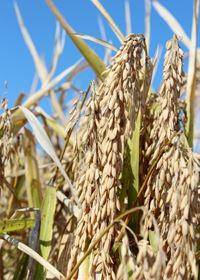|
Mid Season Gives Rice High-Quality Harvest
MISSISSIPPI STATE, MISS.
After a late start for the planting season raised fears that a hot August could damage the crop, Mississippi’s rice has yielded a high-quality harvest.
The Oct. 20 U.S. Department of Agriculture crop progress and condition report indicated the state’s rice crop was 96 percent harvested. The crop’s quality was rated as 50 percent good and 25 percent excellent.

Even after a late start, a favorable growing season allowed for a timely harvest of Mississippi’s rice, such as this grown at the Delta Research and Extension Center in Stoneville. The U.S. Department of Agriculture reports the crop was 96 percent harvested by Oct. 20, 2013.
Photo by MSU Ag Communications/Keri Collins Lewis
Tim Walker, rice agronomist with the Mississippi State University Extension Service, said grain quality is based on several factors, including translucence.
“Because temperatures were so mild this summer, chalk is down considerably compared to the last few years,” Walker said. “Clear, as opposed to opaque, rice helps us in the marketplace and makes us competitive with South American rice, namely rice from Uruguay and Brazil.”
Walker, who works out of the Delta Research and Extension Center in Stoneville, said rice producers had a reason to fear summer heat.
“We had only planted 15 percent of the crop by the first of May,” he said. “Typically we would be about 60 percent planted by then, and in 2012 we were at 95 percent planted, so we felt very behind. But fortunately, the whole year had very mild temperatures. This year was in the top five in terms of coolest temperatures in the last 84 years.”
Disease and pest pressure were both light this season, which benefited the crop.
“There were a few instances of leaf blast in a couple varieties, but no associated yield reductions,” Walker said. “Late-season stink bugs were our biggest pest problem, but they impacted about the first 50 percent of the crop, and after that stink bug pressure subsided.”
As in most years when springtime is wet, glyphosate drift was a challenge for rice growers. Walker said he ended up replanting more rice than usual because of drift damage and slow growing conditions.
Mississippi growers planted 122,000 acres in rice this year, down about 4,000 acres from 2012. The most recent USDA report is from September, and it predicted yields of 7,100 pounds per acre. Walker said he expects final figures to be higher.
John Michael Riley, Extension agricultural economist, said he expects yields to compensate for decreased acreage. The August rice stocks report from USDA’s National Agricultural Statistics Service revealed a total of 30.52 million hundredweight in inventories across the U.S., 15 percent below last year’s totals.
“Those who have the land and machinery more suited to rice are staying in the game,” Riley said. “Nationally, there were fewer acres this year, but that may be offset just a bit by slightly higher yields. Total U.S. production is currently projected to be down 7 percent from 2012.”
Riley said better prices are the result of low supplies carried over from last year and a smaller 2013 crop.
“The September rice futures contract finished at $16.15 per hundredweight, which was about $1 higher than one year ago,” he said. “Currently, the November contract is at $15.54, about $1 higher than last year.”
Larry Falconer, an Extension agricultural economist in Stoneville, said rice producers may have lower production costs in 2014.
“It appears that fertilizer prices will be considerably below prices seen early this year,” Falconer said. “Urea prices, the primary source used for nitrogen, are down 26 percent from this time last year, and diesel prices are down about 8 percent.”
If these price levels hold through next season, growers could see production costs drop by as much as $40 per acre, depending on the production system used.
Rice growers may soon have more good news out of the Delta Research and Extension Center in the form of a potential new variety of rice.
Walker, who is also a researcher with the Mississippi Agricultural and Forestry Experiment Station, said the seed now growing in research plots in Puerto Rico will be harvested in February and planted in Mississippi for the final stages of testing.∆
|
|